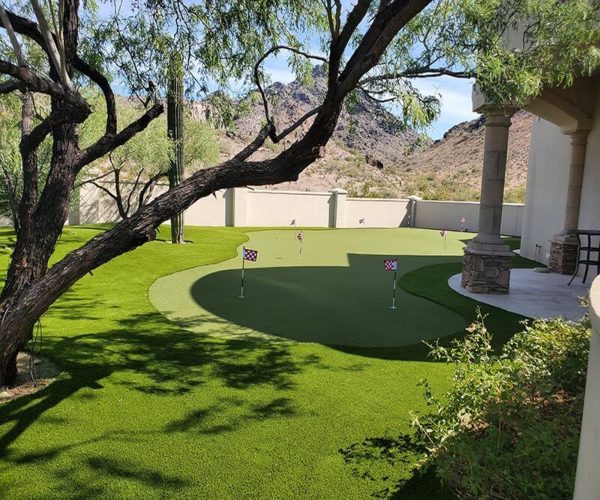The History of Artificial Turf
Origins and AstroTurf: A solution to an Engineering Problem

Artificial grass originated not as a mere commodity, but as an ingenious solution to a pressing engineering dilemma. Artificial grass was originally created because the US government saw that urban children were less fit than rural children due to lack of access to green space. They theorized that the reason for this was lack of green spaces in urban environments. Monsanto, a renowned chemical company, was asked to create an artificial grass and in 1964, an early version of the turf was installed at the Moses Brown School’s recreation area in Providence, Rhode Island. The artificial grass was named Chemlawn.
Chemlawn receive widespread attention in 1966 when it was installed at the Astrodome in Houston, Texas. Initially , the Astrodome tried to use natural grass in its opening season in 1965, but this was unsuccessful, leading to poor field conditions and dead grass that was painted green. In April, 1966, due to limited availability of artificial turf, only the infield was covered with it for the Houston Astros’ home opener. The outfield received the turf in early summer, during an Astros road trip, and was first used after the All-Star Break in July. Because of the publicity surrounding this development, the name of the turf was changed to Astroturf®.
This innovative solution didn’t just save the Astrodome’s playing field; it also fundamentally transformed our understanding of what turf could be, opening the door to synthetic, man-made alternatives that have since revolutionized indoor and outdoor sports venues worldwide.
The Rise of Competitors and Technological Advancements
AstroTurf’s success spawned a new market, leading to the emergence of competitors. As other companies started to develop their own versions of man-made turf, the race for better and more realistic turf began. Innovations like rubber infill, which made the fake grass softer and safer, became new standards. Third generation artificial turf came into being in the late 1990s and early 2000s and incorporated sand and rubber particles to imitate soil, providing even better shock absorption and a more natural appearance.
Synthetic Grass for Various Applications
As the technology improved, the application of artificial grass went beyond sports fields. Homeowners started adopting artificial grass for their lawns. Businesses used it to “green up” their concrete spaces, and schools and municipalities adopted it for playgrounds. Golfers started using artificial turf for practice putting greens. Each new application came with specialized needs for drainage, texture, and pile height, leading to various types of turf engineered for specific purposes.
Artificial Turf in Sports
In the sports world, artificial turf has gained significant acceptance. From football, tennis, soccer, and baseball, each sport has its own specific type of artificial turf to suit their needs. Some sports bodies, like FIFA, have established rigorous standards for artificial turf to ensure player safety and performance. The versatility of artificial turf has effectively removed geographic and climate constraints, allowing sports to be played in varied conditions.
Shifting Attitudes: From Stigma to Acceptance
Early versions of artificial turf faced criticism for being too hard, leading to injuries, and for lacking the natural feel of grass. However, advanced manufacturing processes have put most of these concerns to rest. Today, artificial grass is not just accepted; it’s often preferred for its low maintenance and durability.
Sustainability Concerns and Innovations
The environmental footprint of artificial turf has been a point of contention in the past. Early versions were non-biodegradable and had a limited lifespan, leading to landfill waste. However, the industry has focused on its sustainability, water conservation, reduction of herbicides, pesticides, and gasoline with innovations that answer the early critics. Products made of recycled materials and organic infills are gradually entering the market, reflecting growing environmental awareness.
Looking to the Future: What Lies Ahead
As we look ahead, the future of artificial turf appears exceptionally promising, propelled by relentless technological advancements. There is a growing emphasis on creating versions of artificial turfs that are not just uncannily realistic but also far more sustainable than their predecessors. In an age increasingly defined by climate change and environmental concerns, drought resistant landscaping options like artificial turf are poised for greater adoption. The journey from Astroturf’s initial days in the Houston Astrodome to today’s multifaceted advanced variants is an example of human ingenuity and adaptability. Through continuing innovation, we can anticipate a new generation of artificial turfs that are not just functional substitutes but also eco-friendly, safer, and almost indistinguishable from natural grass, fulfilling the promise of green spaces and environments where natural turf would otherwise fail to thrive.
Who to Call
With over 20 years of experience, Las Vegas Artificial Lawns is the trusted artificial grass installer in the Las Vegas, North Las Vegas, Spring Valley, Paradise, and Henderson areas. Using the latest in technological advances, our expert team ensures a seamless process by assisting customers in selecting and installing the right system for their specific needs. Whether you are just in the process of planning or are ready to install a new lawn right away, the professionals here at Las Vegas Artificial Lawns want to help you create a luxurious new landscaped oasis!
If you’d like more information about the products and services we offer, contact us via our website, or give us a call us for a free design consultation at 702-389-7276.
